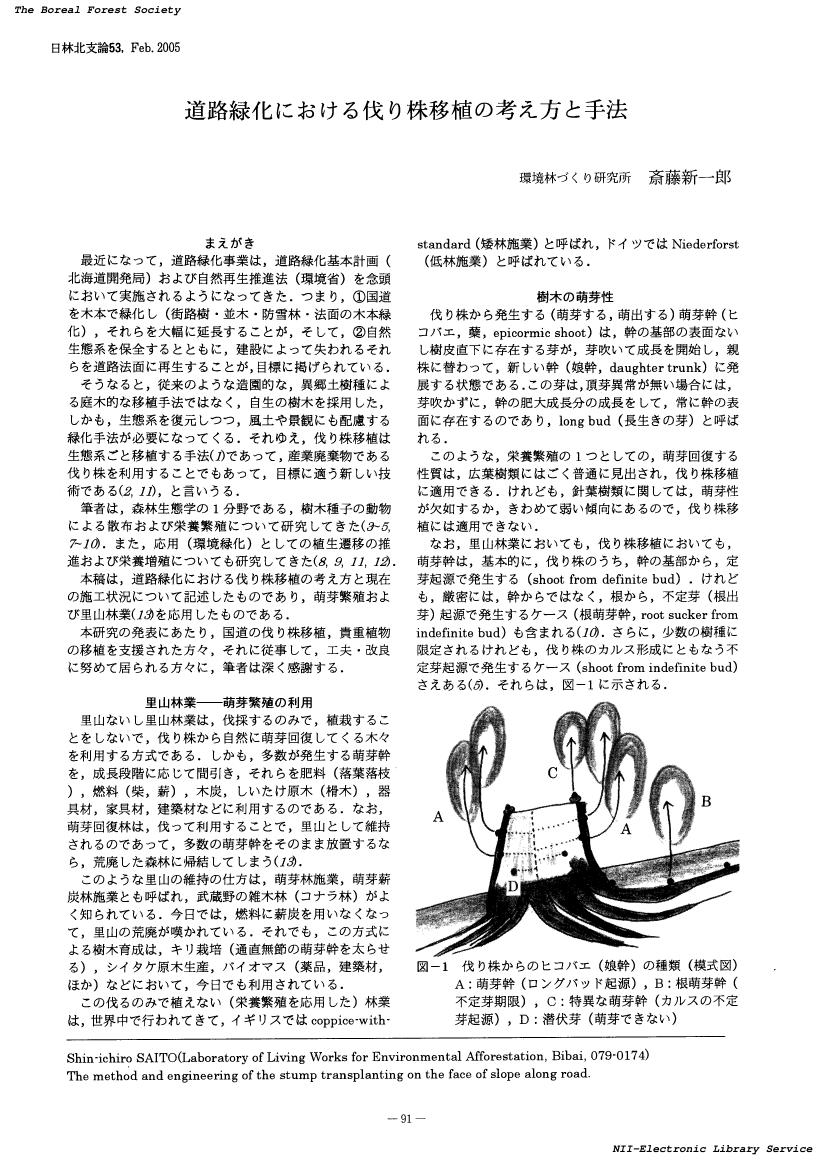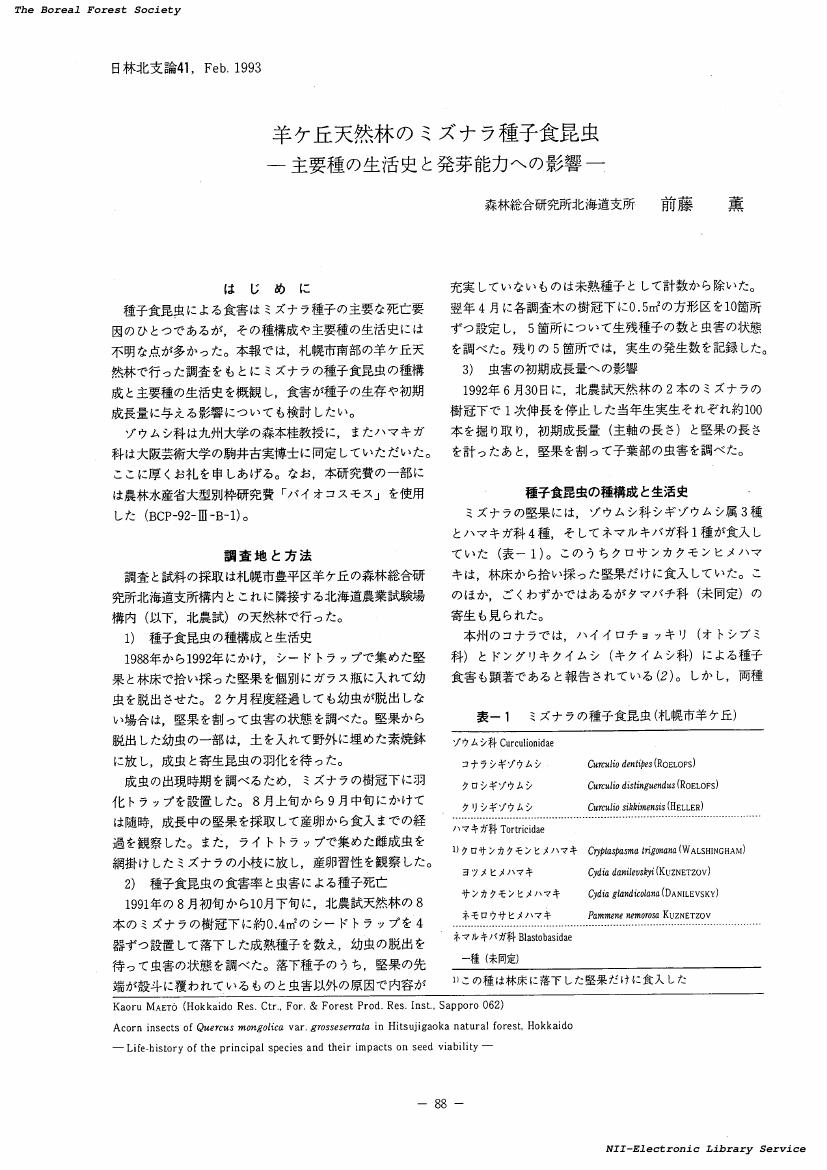7 0 0 0 OA 北海道胆振東部地震で発生した崩壊斜面における植生の初期自然回復状況
- 著者
- 小口 健夫
- 出版者
- 北方森林学会
- 雑誌
- 日本林学会北海道支部論文集
- 巻号頁・発行日
- vol.41, pp.61-62, 1993
4 0 0 0 世界の家具(特別講演)
- 著者
- 長原 実
- 出版者
- 北方森林学会
- 雑誌
- 日本林學會北海道支部講演集
- 巻号頁・発行日
- no.31, pp.1-3, 1983-03-20
家具の歴史をさかのぼろうとすれば,それはメソポタミアで,最古の文明をつくったとされるシュメール人達が,すでに粘土でつくった腰掛にすわっていたようであるから,紀元前3000年〜4000年までさかのぼることができるようである。木製家具が造られるようになったのは,かなり後になってからであるが,それでもローマ時代には権力の象徴としての玉座があり,庶民的生活用具として素朴な木製椅子が用いられていた,と考えられる。以来ロマニック,ゴシック,ルネサンス,バロック,そして華麗さにおいてその頂点といわれるロココスタイル,即ち16世紀から17世紀前半を界として次第にシンプルナイズされて来る。そして19世紀末にはモダニズムが台頭して来るといった具合に,家具はインテリアデザインと相まって何時の時代にも建築文化とともに歩んで来た,といえる。しかし,ここでは古典について長々と解説するつもりはない。今世紀,即ち近代家具が世界的にどのような動きを示したか,について私が1963年から67年までの家具研究のための滞欧生活,そしてその後十数年間家具製造業を営みながら,毎年数度の海外旅行によって得た経験から,世界の家具について特徴的活動を地域,あるいは人物によって追跡してみようと試みたものである。
2 0 0 0 OA サケ由来の栄養が河畔林内の菌類(キノコ)に及ぼす影響(会員研究発表論文)
- 著者
- 長坂 有 長坂 晶子
- 出版者
- 北方森林学会
- 雑誌
- 北方森林研究 (ISSN:21867526)
- 巻号頁・発行日
- vol.61, pp.109-112, 2013-02-18 (Released:2018-04-04)
- 著者
- 小笠原 繁男 高橋 稔 島 強 佐藤 昭一 倉橋 昭夫
- 出版者
- 北方森林学会
- 雑誌
- 日本林学会北海道支部論文集 (ISSN:09123342)
- 巻号頁・発行日
- no.38, pp.32-34, 1990-03-01
1 0 0 0 OA 道路緑化における伐り株移植の考え方と手法(会員研究発表論文)
- 著者
- 斎藤 新一郎
- 出版者
- 北方森林学会
- 雑誌
- 日本森林学会北海道支部論文集 (ISSN:18827039)
- 巻号頁・発行日
- vol.53, pp.91-94, 2005-02-01 (Released:2018-04-04)
1 0 0 0 OA 生分解性不織布コンテナ苗の植栽後の根の成長
- 著者
- 来田 和人
- 出版者
- 北方森林学会
- 雑誌
- 北方森林研究 (ISSN:21867526)
- 巻号頁・発行日
- vol.70, pp.27-30, 2022 (Released:2022-03-30)
1 0 0 0 道路凍結防止剤の植物への影響(会員研究発表論文)
- 著者
- 春木 雅寛 上野 義晴
- 出版者
- 北方森林学会
- 雑誌
- 日本林学会北海道支部論文集
- 巻号頁・発行日
- vol.48, pp.151-153, 2000
1 0 0 0 砂防工事による環境修景について(会員研究発表講演)
- 著者
- 安田 伸生
- 出版者
- 北方森林学会
- 雑誌
- 日本林學會北海道支部講演集
- 巻号頁・発行日
- vol.26, pp.34-37, 1978
1 0 0 0 OA 米国西北部のストローブマツ発疹さび病について(特別講演)
- 著者
- 佐保 春芳
- 出版者
- 北方森林学会
- 雑誌
- 日本林學會北海道支部講演集
- 巻号頁・発行日
- no.14, pp.1-5, 1965-12-25
- 著者
- 高橋 郁雄 佐保 春芳
- 出版者
- 北方森林学会
- 雑誌
- 日本林學會北海道支部講演集
- 巻号頁・発行日
- vol.20, pp.181-186, 1972
The larch canker was reported in the Tokyo University Forest in Hokkaido in 1969. Its pathogen, Encoeliorsis laricina (E_<TTL>.) G_<ROVES> (Imperfect state : Brunchorstia laricina E_<TTL>.). was cultured on a potato-galactose-ager medium and fungus colonies on this medium were used for the inoculation experiments. The inoculations were made on Feb. 17, 1970 and March, 16, 1970 on the potted larch seedlings in the green house, quite earlier than the natural condition. The methods of inoculation was as follows. Each main stem and side branch of seedlings were sterilized with 80% alcohol and washed with water, and a peeling abrasion (4mm x 4mm) was made with a sterilized knife on the bark. The pieces of the mycelial colony were placed at the injured part. After that, the plants were placed in a moist chamber and held at the relative humidity of 80-100% and at 15℃ temperature for two weeks. Then, they were placed in the natural condition. Pycnidia were recognized on all inoculated seedlings such as, Larix gmelinii, L. g. var. Koreana, L. leptolepis and L. sibirica fifty days later. Many apothecia were observed on L. g. var. Koreana, a few were on L. leptolepis and few were on L. gmelinii and L. sibirica 476 days later. On the other hand, inoculations with conidia obtained from spore horns of pycnidia were made on May 13, 1970. Spore horns were stired in distilled water, this suspension was spread on the trunks and branches that were treated by sterilized stainless steel needle to make wounds (20 wounds in 4mm^2). After the spreading with the suspension, the plants were placed in a moist chamber for five days. The discoloration was observed on all of the treatment seedlings ten days later, and pycnidia were recognized on L. gmelinii, L. g. var. Koreana and L. leptolepis. No fruit bodies were found on L. sibirica. Under the results of the experiments, L. g. var. Koreana seemed to be the most susceptible to the fungus, and these results were similar to the field observations.
- 著者
- 土屋 禎治
- 出版者
- 北方森林学会
- 雑誌
- 日本森林学会北海道支部論文集 (ISSN:18827039)
- 巻号頁・発行日
- vol.54, pp.90-92, 2006
1 0 0 0 OA 砂防工事による環境修景について(会員研究発表講演)
- 著者
- 安田 伸生
- 出版者
- 北方森林学会
- 雑誌
- 日本林學會北海道支部講演集 (ISSN:24330825)
- 巻号頁・発行日
- vol.26, pp.34-37, 1978-02-15 (Released:2018-04-04)
1 0 0 0 カラマツ壮齢木における野ネズミ被害後の成長(会員研究発表論文)
- 著者
- 中田 圭亮 近藤 和男 北川 善一
- 出版者
- 北方森林学会
- 雑誌
- 日本林学会北海道支部論文集
- 巻号頁・発行日
- vol.41, pp.79-81, 1993
- 著者
- 前藤 薫
- 出版者
- 北方森林学会
- 雑誌
- 日本林学会北海道支部論文集 (ISSN:24330817)
- 巻号頁・発行日
- vol.41, pp.88-90, 1993-02-28 (Released:2018-04-04)
- 被引用文献数
- 1
1 0 0 0 OA ウダイカンバ再生林の立木度とその生長経過(会員研究発表講演)
- 著者
- 安達 守 佐藤 昭一 伊藤 務 今野 進
- 出版者
- 北方森林学会
- 雑誌
- 日本林學會北海道支部講演集 (ISSN:24330825)
- 巻号頁・発行日
- vol.28, pp.23-25, 1980-02-28 (Released:2018-04-04)
- 著者
- 真田 勝 大友 玲子 真田 悦子
- 出版者
- 北方森林学会
- 雑誌
- 日本林學會北海道支部講演集
- 巻号頁・発行日
- vol.31, pp.65-67, 1983
1 0 0 0 OA 厚真町広葉樹二次林での植生と埋土種子相の関係(会員研究発表論文)
- 著者
- 渡辺 一郎 滝谷 美香 大野 泰之
- 出版者
- 北方森林学会
- 雑誌
- 日本森林学会北海道支部論文集 (ISSN:18827039)
- 巻号頁・発行日
- vol.54, pp.30-32, 2006-02-24 (Released:2018-04-04)
1 0 0 0 OA 機械地拵えにおけるGPSトラッキングの利用可能性(会員研究発表論文)
1 0 0 0 The Spectral Data Collection of Specific Trees in Peat-Forest in Central Kalimantan, Indonesia
- 著者
- セガ ヘンドリック 谷 宏 大崎 満 エヴリ ムハンマド ウスップ アスウィン
- 出版者
- 北方森林学会
- 雑誌
- 北方森林研究 (ISSN:21867526)
- 巻号頁・発行日
- vol.61, pp.73-76, 2013








